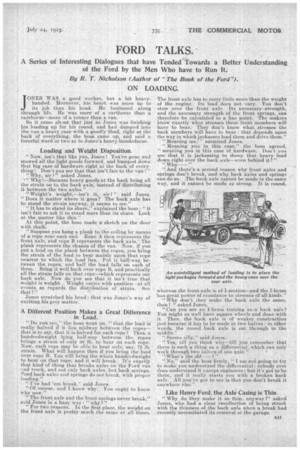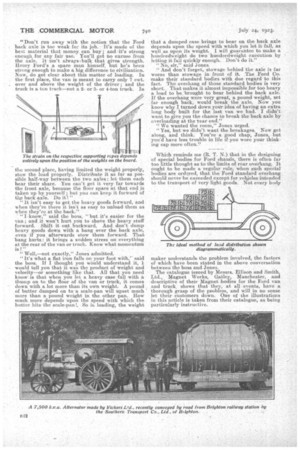FORD TALKS.
Page 27

Page 28

If you've noticed an error in this article please click here to report it so we can fix it.
A Series of Interesting Dialogues that have Tended Towards a Better Understanding of the Ford by the Men Who have to Run It.
By R. T. Nicholson (Author of "The Book of the Ford"). ON LOADING.
JONES WAS a good worker, but a bit heavyhanded. Moreover, his heart was more up to its job than his head. He lumbered along through life. He Was more of a carthorse than a racehorse—more of a tonner than a van.
. So it came about that just as Jones was • finishing his loading up for his round, and had dumped into the van a heavy case with a goodly thud, right at the back of everything, the boss came up, and said a forceful word OT two as to Jones's heavy-handedness.
. Loading and Weight Disposition. .
"Now, isn't that like you, Jones? You've gone and stowed all the light goods forward, and bumped down that big case of hardware right at the back of everything' Don't you see that that isn't fair to the van?" "Why sir ? ' asked Jones. '‘" Why !—Because heavy goods at the back bring all the strain on to the back axle; instead of diStribiiting it between the two axles." .
"Weight's weight,—isn't it, sir ? " said Jones. "Does it matter where it goes ? The 'back axle has to stand the strain anyway, it seems to me." "It has to stand its share," explained the boss : "it isn't fair to ask it to stand more than its share. Look at the matter like this."
At this point, the boss made a sketch on the door with chalk.
"Suppose you hang a plank to the ceiling by means of a rope near each end. Rope A then represents the front axle, and rope B represents the back axle.' The plank represents the. Chassis of the van. Now, if you put a load on the plank between the ropes, you bring the strain of the load to bear mainly upon that rope nearest to which the load lies. Put it half-way between the ropes, arid half the load falls on each of them. Bring it well back over rope B. and practically all the strain falls on that rope—which represents our back axle. Now do you see that it isn't true that weight is weight. Weight varies with position—at all events as regards the distribution of strain. See that ? "
Jones scratched his head: that was Jones's way of exciting his grey matter.
A Different Position Makes a Great Difference in Load.
'Do you see," the boss went on, "that the load is really halved if it lies midway between the ropes— that is to say, that it is halved for each rope ? Thus, a hundredweight lying half-way between . the ropes brings a strain of only 56 lb. to bear on each rope. Now, each rope may he able to bear only, say, 75 lb. strain. What Will happen then if you bring the load over rope B. You will bring the whole hundredweight to bear on that rope, and it will break. It's exactly that kind of thing that breaks axles On the Ford van and truck, and not cnly back axles. but back springs. Pord back axles and springs do not break, with proper loading."
"I've had 'ern break," said Jones.
"Of course, and I know why. You ought to know why now."
"The front axle and the front springs never break," , said Jones in a hazy way : " why ?" "For two reasons. In the first place, the weight on the front axle is pretty much the same .at all times. , The front axle has to carry little more than the weight of the engine. Its load does not vary. You don't stow over the front axle. Its necessary-strength, and the necessary strength of the front springs, can therefore be calculated to a fine point. The makers know exactly what stresses these front members will have to bear. They don't know what stresses the back members will have to hear: that depends upon the way in which jackasses load them and drive them."
"Meaning me ! " surmised Jones.
"Meaning youin this case," the boSs agreed, "meaning you in this case of hardware. Don't you see that it is jaekassing to dump that heavy load down right over the back axle--even behind it? "
" Why— " "And there's a second reason why front axles and springs don't break, and why back axles and springs can do so. The back axle cannot he made in the same way, and it cannot be made as strong. It is round, whereas the front axle is of 1-section—and the 1-beam has great power of resistance to stresses of all kinds." "Why don't they make the back axle the .sae, then ? "asked Jones."
"Can you see an I-beam turning as,a back axle ? You might as well have square wheels and done with it, Then; the back axle is of weaker construction just because' it has to be made in two halves : in other words, the round back axle is cut through in the
", Seems silly," said Jones.
"Yes, till you think why—till you remember that there is such a thing as a differential, which can only work through two halves' of One axle."
"What's the dif--? "
"N9," said the boss firmly, "I am not going to try to make you understand the differential : nobody ever does understand it except engineers ; 'but it's got to be there, and it really starts you with a broken back axle. All you've got to see is that you don't break it anywhere else.'
Like Henry Ford, the Axle Casing is Thin.
"Why do they make it so thin, anyway ?" asked Jones, who had a clear recollection of being struck with the thinness of the back axle when a break had recently necessitated its removal at the garage.
":Don't run away with the notion that the Ford back axle is toe weak for its job. 'It's made of the best material that money can buy; audit's strong enough, for any fair use. You'll get no excuse from the axle.. It isn't always 'bulk that gives strength. Henry Ford's a spare man himself, but he's been strong enough to make a big difference to civilization. Now, do get clear about this matter of loading. • In the first place, the van is meant to carry only 7 cwt. over and above the weight of the driver ; and the truck is a ton truck—not a 2or .3or 4-ton truck. In
the second place, having limited the weight properly, stow the load properly. Distribute it as far as passible half-way between the two axles : let them each bear their share. You can't get it very far towards the front axle, because the floor space at that end is taken up by yourself ; but you can keep it forward Ow back axle. Do it I " "It isn't easy to get the heavy goods forward, and -when they're there it isn't as easy to unload them as when they're at the back.". "I know," said the boss, " but it's easier for the van ; and it won't hurt you to shove the heavy stuff forward. Shift it out backvvard. And don't dump heavy goods down with a bang over the back axle, even if you afterwards stow them forward. That bang hurts : it brings a sadden stress on everything at the rear of the van or truck. Know what momentum is?"
"Well,—not exactly," Jones admitted. "It's what a flat iron falls on your foot with,' said the boss. If I thought you would understand it, I would tell you that it was the product of weight and velocity—or something like that. All that you need know is that when you let a heavy case fall with a thump on to the floor of the van or truck, it comes down with a lot more than its own weight. A pound of butter dumped on to 'a scale-pan will upset much more than a pound weight in the other pan. How much more depends upon the speed with which the butter hits the scale-pan!, So in loading, the weight that a dumped ease brings to bear on the back axle depends upon the speed with which you let it fall, as well as upon its weight. I will guarantee to make a hundredweight do two hundredweight execution by letting it fall quickly enough. Don't do it." " No, sir," said Jones. " And don't forget, stowage behind the axle is far worse than stowage in front of it. The Ford Co. make their standard bodies with due regard to this fact. The overhang of those standard bodies is very short. That makes it almost impossible for too heavy a load to be:brought to bear behind the back axle. If the overhang were very great, a pound weight, set far enough back, would break the axle. Now you know why I turned down your idea of having an extra long body built for the last van we had. I didn't want to give you the chance to break the back axle by overloading at the Tear end." " We wanted the room," Jones urged. "Yes, but we didn't want the breakages. Now get along, and think. You're a good chap, Jones, but you'd have less trouble in life if you wore your thinking cap more often."
Which reminds me (It T. N.) that in the designing of special bodies for Ford chassis, there is often far too little thought as to the limits of rear overhang. It ought to be made a regular rule, when such special bodies are ordered, that the Ford standard overhang should never be exceeded except for vehicles intended to the transport of very light goods. Not every body maker understands the problem involved, the factors of which have been stated in the above conversation between the boss and Jones. The catalogue issued by Messrs. Ellison and Smith, Ltd., Magnet Works, Gatley, Manchester, and descriptive of their Magnet bodies for the Ford van and truck, shows that they, at all events, have a thorough grasp of the problem, and will in no sense let their customers down. One of the illustrations in this article is taken from their catalogue, as being particularly instructive.
































